Children's Hospital
321 Sydenham Road, Sydenham, SE26 5ER
Medical dates:
Medical character:
1872 - 1991
Acute
In 1872 Miss Edith Elwes opened the Home and Infirmary for Sick Children and South London Dispensary for Women. Free treatment and care were provided for the sick children of the poor of Sydenham, who at that time lived in 'squalid conditions'. Boys aged between 2 and 12 years and girls between 2 and 14 years were admitted, excepting those suffering from epilepsy or infectious diseases.
Originally occupying two houses at 5-6 Albion Villas Road, the Home moved to Champion House in Sydenham Road in 1885.
In 1903 the Home was closed due to a measles outbreak and, in the following year, because of a scarlet fever outbreak. Following that episode it was decided that the drainage system had to be improved, but the cost of £1000 for work brought severe financial worries.A new operating theatre, paid for by the surgeon Mr Gerald Crecy Parnell, was installed in 1905 in what had been the convalescent ward on the first floor. The room above it became the infants' ward and a new servants' bedroom was built above that at the cost of £185.
In 1906 an Out-Patients Department opened. A mortuary and post-mortem room were also built. The hospital was renamed the rather unwieldy 'The Home and Infirmary for Sick Children and Out-Patients Department for Women and Children'. It had 57 beds.
Another infectious disease outbreak - diphtheria this time - forced the Home to close at the end of 1907. It reopened in February 1908.
The Home treated children surgically for the removal of adenoids and tonsils, cauterization of naevi (moles), fractures, lacerations and circumcision (for phimosis). Medical admissions were for marasmus and rickets (diseases of malnutrition), bronchitis, influenza, rheumatoid arthritis, hip disease, scalds and burns, septic conditions (abscesses) and - surprisingly, for a hospital that did not admit children with infectious diseases - measles, impetigo, pulmonary tuberculosis, as well as TB of the spine and tabes mesenterica (TB of the abdominal lymph glands caused by drinking infected cow's milk).
In 1909 the kitchen garden, which had not proved to be that useful, was added to the children's playground area and partly asphalted. A convalescent home - Whittuck Home - with 12 beds was opened at Broadstairs.
An external staircase was added as a fire escape in 1910, at a cost of £2000. In 1912 a shed was erected to provide protection from the weather for those who had been unable to find a place in the Out-Patients Department waiting room. In 1913 an X-ray apparatus was installed. The King sent £5 to be used towards the cost of entertainment for the children; the Queen sent 25 pheasants. By this time the Home was treating schoolchildren referred by the LCC for treatment of eye and ear conditions.
In 1914 the name was changed again, to the Hospital and Home for Sick Children, to bring it into line with similar institutions. Whittuck Home closed at the outbreak of WW1 (and also for financial reasons) and the building was offered to the Red Cross Society and the Committee for Belgian Refugess. The Out-Patients Department at Sydenham Road was closed for the duration of the war and 6 beds were offered to the children of Belgian refugees.
In 1918 it was renamed again, as the South Eastern Hospital for Children, as it was now receiving children from all parts of London. The LCC continues to send cases; during 1918 some 368 children had their tonsils and adenoids removed, 193 of whom had been referred by the LCC. A Nurses Home, which could accommodate 17 nurses, opened at 3 Burghill Road. Whittuck Home remained closed.
In 1920 the tradesmen of Sydenham raised funds for the erection of a laundry at the Hospital as a war memorial. In 1924 the Hospital was extended. Queen Mary visited in 1926 and formally opened a newly built Nurses' Home.
By 1939, at the outbreak of WW2, the Hospital had 100 beds and cots.
It joined the NHS in 1948 as the Children's Hospital (Sydenham) and enjoyed an excellent reputation for its provision of care for children.
It closed in 1991 with 67 beds. Services transferred to new facilities (which, for a while, were known as the Children's Hospital) on the Lewisham Hospital site. This is now a centre for general paediatric surgery and for rhesus disease, with a separate Accident and Emergency Department adjacent to the adult one. It treats children referred from South East England.
|
Present status (January 2008) |
|---|
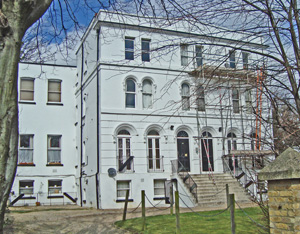
The first site of the Hospital at Nos. 5 and 6 Albion Villas Road.
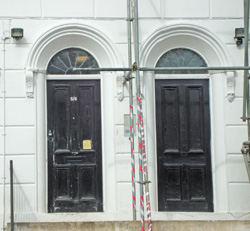
The entrance to Nos. 5 and 6 is the door on the left.
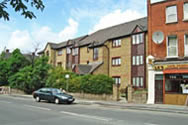
The Sydenham Road frontage with new housing.
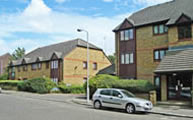
The entrance to Castle Court off Champion Road.

The corner of Sydenham Road and Champion Road.
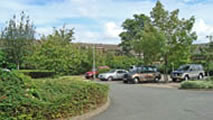
New housing in Castle Court.
|
The average cost of keeping an in-patient at the Home for a week. In 1908 bricklayers and plumbers earned about £2 per week; fitters, turners and smiths in the engineering trades up to £1 16s (£1.80); labourers up to £1 7s (£1.35), but farm labourers about 13s 5d (67p). |
|
| 1908 | £5 3s 4d (£5.17) |
| 1909 | £4 19s 11d (£5) |
| 1910 | £4 2s 9-3/4d (£4.14) |
| 1911 | £4 6s 7-3/4d (£4.33) (Whittuck Home = £4 13s 10-1/2d) (£4.69) |
| 1912 | £4 14s 2-1/4d (£4.69) (Whittuck Home = £7 14s 9-3/4d) (£7.74) |
| 1913 | £4 11s 3d (£4.56) (Whittuck Home = £5 8s 2-1/2d) (£5.41) |
| 1914 | £4 11s 3d (£4.56) (Whittuck Home = £8 2s 8d) (£8.13) |
| 1915 | £5 3s 3d (£5.16) |
| 1916 | £7 8s 11 (£7.45) |
| 1917 | £5 4s 8d (£5.23) |
| 1918 | £7 17s 10d (£7.89) |
References (Accessed 6th November 2014)
http://lewishamwarmemorials.wikidot.com
www.flickr.com
www.lewisham.nhs.uk
www.london-footprints.co.uk
www.uhl.ac.uk